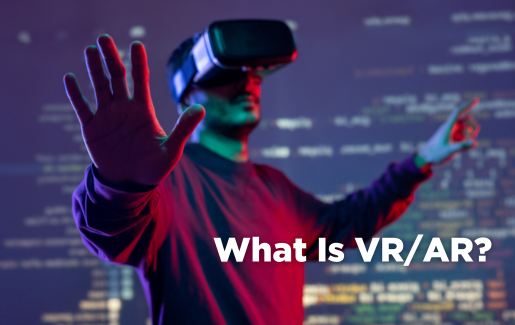
Virtual reality (VR) is all in your head. Literally. Your hands and arms, as well as your feet and legs, may also be involved, but the real engagement and most of the experience is your mind reacting to visual and auditory stimuli provided by various types of headgear. Your field of vision is encompassed by an immersive virtual environment created by image projection technology. The images are sometimes photorealistic and sometimes stylized, depending on the purpose of the simulated environment. You don't physically go anywhere, but with the right simulation you can go anywhere and do anything.
Put simply, VR is the immersive projection of images and sound to replicate an interactive physical environment that is not tangibly present except in the mind of the user.
How Virtual Reality Works
Most humans have a field of vision that lets us perceive our immediate environment in a roughly ear-to-ear arc of somewhere between 200 and 220 degrees. You can't see across the entire range with both eyes at once since your "binocular" field of vision is only about 114 degrees. That's the sweet spot for VR technology. Instead of accommodating your full range of vision, most modern headgear is limited to the range of vision where both eyes are engaged, and most VR developers concentrate on the middle 90 degrees of that range.
What you see when you look through a VR headset could generically be described as a "movie," but it's not the sort of movie that you're used to seeing in theaters. With a couple of recent detours into "high frame rate" projection, or HFR, movies have been shown for decades at a fairly standard frame rate of 24 FPS, or frames per second. (Broadcast TV has generally used a slightly higher frame rate of 30 FPS.)
That's not good enough for VR. Humans can process images projected up to about 150 FPS without losing information, and trial and error has revealed that VR frame rates below 60 FPS are problematically disorienting and can cause physical discomfort. The standard is evolving, but current VR headsets typically settle in around 90 FPS. Accompanying sound is typically generated via spatial (or 3D) audio.
The glue of the VR experience, however, is motion tracking, which is essentially what allows the headset to tell where you're looking and adjust what you see accordingly. Headsets that are limited to "three degrees of freedom," or 3DoF, adjust the display when you look left, right, up or down. High-end VR uses 6DoF and adjusts the display no matter where you look or how you turn.
Types of VR
VR tools are generally classified into a handful of broad categories. The defining characteristic is more or less how the user experiences the simulated environment. There are two key factors in play:
- How convincing is the illusion?
- What degree of interaction is available?
Non-Immersive Virtual Reality: At this level, the user experiences limited interaction with a realistic virtual environment. The user observes the environment but does not experience the sensation of being inside of it. Some features are responsive, and the user can manipulate certain elements. Users mostly control their actions via typical handheld input devices like a mouse or joystick.
Standard console video games are an example of non-immersive virtual reality. The user is looking at and interacting with an entirely computer-generated reality. The user can manipulate the virtual environment and control many of its features, and the environment is somewhat responsive.
Semi-Immersive Virtual Reality: This is a middle ground between non-immersive VR and fully immersive VR. The user mostly observes a realistic virtual environment but remains aware of their surrounding physical environment. The images are more realistic and more convincing at this level, and goggles or a headset may be in use, but user control is still typically restricted to handheld input devices.
Semi-immersive VR is often used to teach and practice skills like driving a car or flying a plane. Remote piloting of drone aircraft is another increasingly common application of semi-immersive VR.
Fully Immersive Virtual Reality: Fully immersive VR is expensive and technology-intensive. At this level, the user experiences extensive interaction with a hyper-realistic virtual environment. The user participates in the environment and experiences the sensation of being fully inside of it. Most features are responsive, and the user can manipulate a wide range of elements. Users can control their actions via wearable monitors and motion sensors like gloves.
Development here has largely (though not entirely) focused on gaming, virtual sightseeing and other forms of entertainment and leisure. Games can be as simple as table tennis — this was also one of the first activities explored by early video games — or as complex as “Layers of Fear VR,” a first-person haunted house exploration adventure.
Collaborative VR: The goal of collaborative VR is to facilitate contact and interaction between users in different locations using VR tools and processes. Writers and filmmakers who tell stories about characters having various adventures in VR realms (think “Ready Player One”) are generally envisioning a combination of fully immersive VR and collaborative VR. Collaborative VR in the real world, however, is generally more focused on communication than creating a seamlessly convincing alternative reality.
What Are the Components of VR?
As discussed above, non-immersive VR experiences can use familiar computer peripherals (like a mouse or keyboard) or video game controllers.
The component most readily associated with VR, however, is some variety of goggles or headset that cover both eyes and ears. The broad label for devices in this category is head-mounted display (HMD). High-end HMD headsets incorporate inertial measurement units (IMUs) that track head and body position and adjust the display accordingly.
VR can also incorporate various levels of haptic technology, which enables the user to press, gesture or flex, and translates these motions into various outcomes in the virtual environment. Haptic technology can be as simple as a joystick or as complex as the various models of gloves and gauntlets (and some footwear) incorporated by high-end VR.
Industry Applications and Real-Life Use Cases
VR is often associated with futuristic razzle-dazzle like the core concept of the 1999 sci-fi thriller “The Matrix,” where humans project their consciousness into photorealistic virtual avatars in a computer-generated reality. The actual business applications of VR are (at least so far) a little bit more mundane.
Workers in various industries, including first responders, heavy equipment operators or miners often have to carry out their jobs in dangerous circumstances. VR can help them learn how to respond to various hazardous scenarios without actually being in any immediate danger. Similarly, VR can help train individuals like surgeons who have to function precisely in high-pressure circumstances.
VR simulations are also widely used in the automotive industry to design and test vehicles. In essence, any industry that involves prototyping at any level can use VR to work through the early stages of engineering before moving on to physical models and prototypes.
Similarly, VR can be used in architecture and interior design to fully envision — and minutely investigate — everything from homes to office towers before construction begins. Any sort of business that could benefit from seeing a finished product before production starts can benefit from rapidly advancing VR technology.
Advantages and Disadvantages of VR
VR has been evolving for decades and is certain to provide benefits that haven't even occurred to anyone yet. No technology is perfect, of course, and VR has its blind spots and drawbacks. An obvious problem is cost. VR at the most immersive and engaging level can be prohibitively expensive to design and implement. And that's before we get to the price tag for consumers.
As with all technology, VR is subject to various types of disruption by cyber threats and attacks. In 2022, a team of cybersecurity researchers at Louisiana State University successfully hacked a VR movie streaming application. The researchers were able to take over headsets, look at their screens, turn their microphones on and install viruses without being detected.
The specter of addiction loomed over VR even before VR products were commercially available, with authors and screenwriters envisioning hordes of VR-fixated individuals checking out of daily life to increasingly inhabit virtual worlds. Early research on a number of fronts suggests that the potential for serious problems is real.
Where Do We Go From Here?
Depending on who you ask, the future of VR may be so bright we need to wear shades — or at least an Oculus Quest. VR usage has grown by leaps and bounds in recent years, and some forecasts project that the global VR market could increase to $227 billion by 2029, up from $18 billion in 2022.
Mark Zuckerberg, who changed the name of his company from Facebook to Meta — as in metaverse — at the end of 2021, has been a proud supporter of VR. In 2014, he predicted the following at a trade show in Barcelona:
"Pretty soon we’re going to live in a world where everyone has the power to share and experience whole scenes as if you’re just there, right there in person. Imagine being able to sit in front of a campfire and hang out with friends anytime you want. Or being able to watch a movie in a private theater with your friends anytime you want. Imagine holding a group meeting or event anywhere in the world that you want. All these things are going to be possible."
If Zuckerberg can believe it, will the rest of us achieve it?
Want to learn about AR and other innovative technologies?
Join CompTIA’s Technology Interest Groups and start a discussion!

 Add CompTIA to your favorite RSS reader
Add CompTIA to your favorite RSS reader

